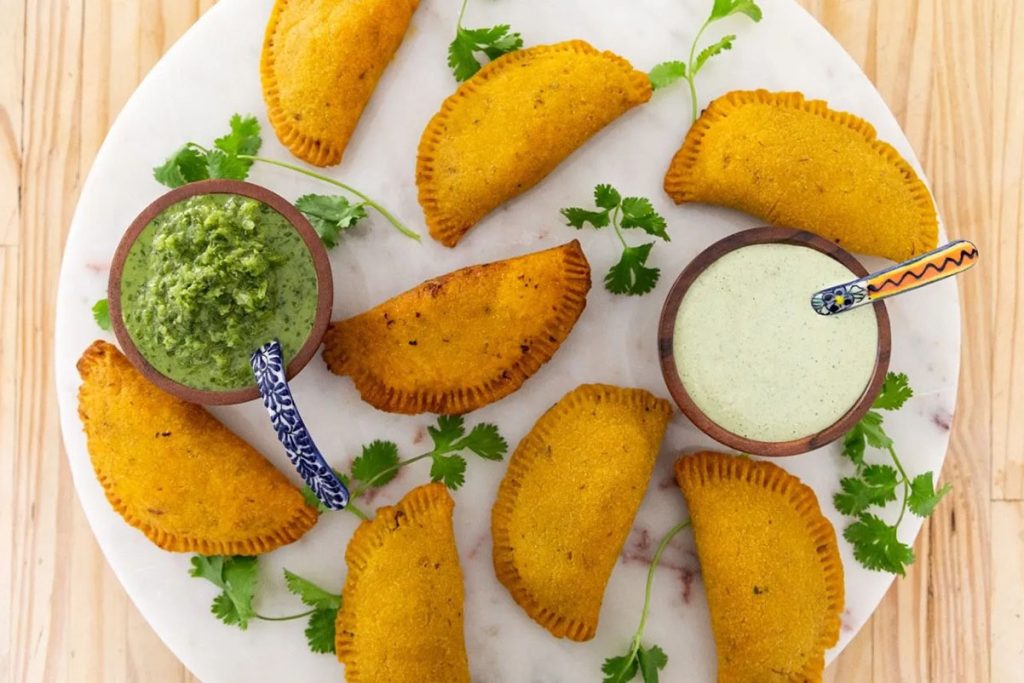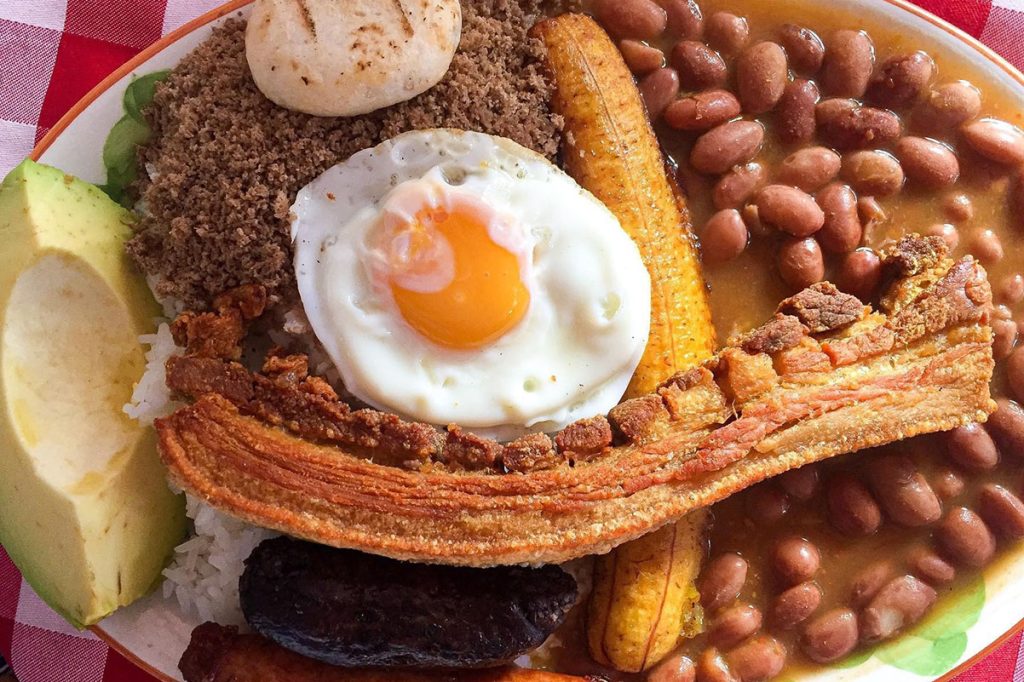South American cuisine is becoming increasingly popular among foodies, and as a result, more and more restaurants inspired by Latin cuisine are emerging in the Netherlands. While typical Colombian cuisine is not yet widely known and lags behind that of Peru and Argentina, Colombia does have its own typical dishes, often depending on the region you find yourself in. Curious? Discover below how you can treat your taste buds with our tips on Colombian food.
A Traditional Colombian dish: Barbecue Arepas
In Colombia, breakfast mainly consists of coffee or hot chocolate (made from fresh cocoa) and cheesy bread rolls. The most famous snack is probably the arepa. These round slices are made from cornmeal and cooked on the barbecue or grill, served warm. Once the arepa is on your plate, poke it with a fork to make small holes; the butter you spread on it will then be absorbed into the bread. Another common practice is to split the arepa open and fill it with cheese.
Pandebono and Buñuelos
Another example of a typical Colombian dish is the pandebono, a bread roll made from cassava flour, cornmeal, and white Colombian cheese. These delicious rolls are dipped in coffee; sometimes Colombians even let them soak in the coffee for a while. Another treat is the buñuelos. Originally served at Christmas with natilla (pudding), buñuelos are actually enjoyed throughout the year in Colombia. These fried dough balls are not the healthiest option, but they are worth a try!
Bandeja Paisa: Colombia’s Calorie Bomb
The classic dish named after the inhabitants of the region where it originates is the Bandeja Paisa. Many Colombians have grown up with it, especially in the area around Medellín, where this dish originally comes from. Saturated with fatty meats and fried ingredients, this dish has a rather bad reputation among health-conscious foodie tourists. However, you cannot leave Colombia without trying this calorie bomb. On your plate, you’ll find rice, beans, finely minced meat, fried plantain (patacón), chorizo, fried pork belly (chicharrón), arepa, and a fried egg. Our tip is to have a light breakfast, go for a nice hike or explore the city, and then order this dish for (late) lunch. You won’t need to eat for the rest of the day!
The World-Famous Empanadas

Many dishes served in Colombia can also be found in other South American countries. For example, you’ll find the world-famous empanadas in every country. However, the empanada is also part of typical Colombian cuisine. You’ll find them everywhere, and they’re often made by Colombian families at home for parties or other special occasions. Empanadas are filled dough pockets that are fried. The filling consists of potato, ground beef, or pieces of beef and pork. An important part of this traditional Colombian snack is the dip served with it, called ají. This dip is made from red pepper, onion, green fresh herbs, and tomato, and it completes the empanada!
Tamales
Another delicacy you’ll find in Colombia, as well as in other South American countries, is the tamale. This traditional snack is quite labor-intensive to prepare, so Colombians often choose to make a large batch and distribute it to everyone. This is something that happens with all food! Tamales are distributed to family, friends, neighbors, the beautician, and the baker on the corner. Anything left over is frozen, so it can be enjoyed for months. Tamales contain a wide mix of ingredients, which can vary greatly from person to person and in taste. Think of potatoes, chicken, pork, peas, corn, and cornmeal. However, the rule is that they are always wrapped in banana leaves. The tamales are then cooked together in a large pot, resulting in a delicious steaming package full of wonderful flavors. Definitely worth a try!
Picada: The Colombian Barbecue
The picada is essentially the Colombian barbecue. It consists of a large variety of pieces of beef, pork, chicken, and sausages with arepas, yuca, patacones, and potatoes. Everything served in one dish or on a banana leaf. This delicious dish is often ordered for several people and you can enjoy it with your hands. Enjoying picada with family and a cold beer is one of the favorite activities of Colombians.
Sancocho
Just as the average Dutch family might fire up the barbecue on a long weekend or a Friday afternoon, Colombians love to cook soup by the river. This soup is called Sancocho, and the exact ingredients vary from family to family. There are no fixed recipe rules for it. Nothing is more Colombian than Sancocho prepared by grandma over an outdoor fire by the river. A good Sancocho has a pronounced smoky flavor and is slightly thickened. This thickness comes from the plantain (cooking banana) in it.
Aguardiente
You can wash down every meal with Colombia’s national drink, Aguardiente. This is a brandy based on sugarcane and anise that absolutely belongs to the national folklore. Nowhere will you find such an extensive variety of Aguardientes as in Colombia. Colombians affectionately call the drink “Guaro”. Guaro is usually drunk neat and ordered by the bottle at parties. The smoothest versions are Aguardiente Antioqueño from the eponymous Antioquia and Nectar sin azucar from Cundinamarca. The most intense variants are Tapa Roja from Tolima and Doble Anis from Huila.
The Colombian Barbecue
Everyone traveling to Colombia must experience a BBQ at least once. As mentioned, they love meat, and a real Colombian BBQ is quite an event! And it’s not just meat that’s served. It doesn’t necessarily have to take place on the street. The well-known grill restaurants are masters at preparing fresh pieces of meat. It’s even more fun if you’re invited to a local ‘s home, so keep your eyes open!
Ajiaco
Chicken soup in the Netherlands, soto soup in Indonesia, and ajiaco in Colombia. It’s something they eat a lot in Colombia and is essentially the Colombian version of our chicken soup. Nothing very special, but still a typical Colombian dish. In addition to chicken, you’ll find potatoes, corn, capers, avocado, and sour cream in the soup, although it’s prepared differently everywhere. However, the most unique ingredient is guasca, a herb with a distinctive flavor!
Bandeja Paisa

You cannot travel to Colombia without trying bandeja paisa. This is the national dish of the country. When talking about food in Colombia, bandeja paisa must not be overlooked. There are incredibly many variations, but the dish often consists of steak, ground beef, chicharrones, rice, beans, egg, avocado, arepa, and fried plantains. You can get it everywhere, even at the well-known street food stalls.
Additional Delicious Colombian Dishes
Lechona: This is a traditional dish from the Tolima department. It consists of a whole roasted pig stuffed with rice, peas, onions, and spices. The result is a flavorful and succulent meat dish that is often served at special occasions and celebrations.
Changua: A hearty and comforting breakfast soup popular in the Andean region of Colombia, especially Bogotá. It’s made with milk, eggs, scallions, and cilantro, often served with a piece of bread for dipping. It’s a perfect dish to start the day, especially on chilly mornings.
Arepas de Huevo: These are fried arepas stuffed with a whole egg, typically eaten as a snack or for breakfast. They are crispy on the outside and soft on the inside, with the egg yolk adding richness to every bite. They are popular street food items, especially on the Caribbean coast.
Sudado de Pollo: A savory chicken stew cooked with tomatoes, onions, garlic, and spices. It’s a comforting and flavorful dish that is often served with rice, potatoes, or yuca. The slow cooking process allows the flavors to meld together, resulting in a delicious and satisfying meal.
Posta Negra: A traditional dish from the Caribbean coast of Colombia, posta negra is a beef stew made with a rich and flavorful sauce consisting of panela (unrefined cane sugar), cola soda, spices, and sometimes chocolate. The result is a sweet and savory dish that is often served with rice and fried plantains.



